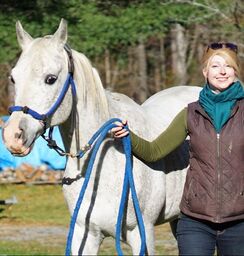
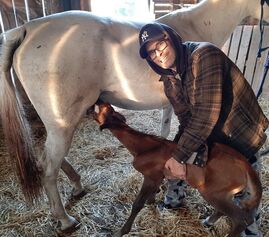
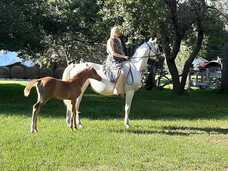
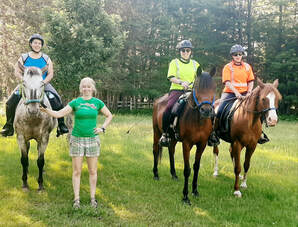
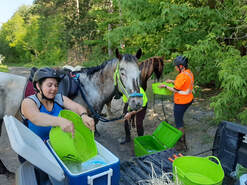
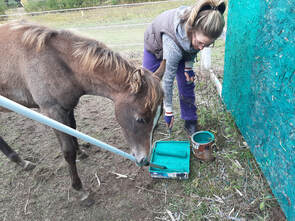
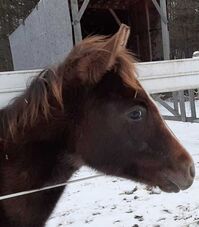
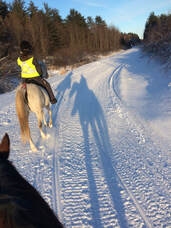
Goodbye to a strange year of wistful endings and wondrous beginnings. May 2021 bring adventure and joy to us all.
Happy New Year from Wildfire Arabians
 This year has been abnormal for Wildfire Arabians, as it has for everyone in the world. In February we said goodbye to TR Prince Nari, the most beautiful stallion I’ve ever known. I was so heartbroken that I barely paid attention to news of an emerging virus. But time marched on and by March the COVID-19 pandemic was dominating our lives – headlines bold and information sparse, and we were sent to telework from home. April was marked by ongoing uncertainty and stress. May brought a mandatory lockdown period, where no visitors were allowed at the farm. Spring took forever, and we were all desperate for good news.  That beautiful stallion that we lost had left us a last gift. After what felt like million days Vienna finally delivered Nari’s first and only Canadian baby on June 15, 2020. This little puddle of fur and legs was christened with a rather grand name to live up to: Wildfire Legacy, in honour of his late father. The following weeks were a chaotic blur of visitors, photos, videos, and Facebook posts. Every single day was dominated by this incredible little creature exploring the world, and the world making his acquaintance.  2020 may have been the worst year for many things, but it turned out to be the best year to have a new baby. Teleworking meant that we could visit and “work with” Legacy multiple times a day, every day, every week, all summer. I can’t imagine another modern foal so thoroughly socialized and exposed. We brought him on forest trails with The Big Horses; we let him roam for hours (supervised) all over the properties; we showed him flappy chickens and loud ATVs and dark barns, all before he had a chance to wonder if they were scary. It helps that mom Vienna is one of the boldest horses in the world and rarely shows any fear – she‘s not called “Sassy Princess Dragonpony” for nothing!  It was a good thing we had little Legacy for us all to play with, because our Endurance season was effectively canceled due to COVID. Without events throughout the summer we seemed to feel a lack of purpose in our riding. Of course, we still had fun – we have incredible trails, amazing horses, and the greatest group of friends – but it felt different, somehow, almost like we were just marking time. For the last several years we’ve attended two or three events a year, giving us an opportunity to enjoy new trails and push ourselves a little further than we normally would, but this year we just… floated. In a way, it was slightly melancholy. In a way, it was a time to breathe, relax, and regroup. No coin has only one face.  Restrictions on the number of individuals allowed at social gatherings curtailed most of the other fun events we would have had at the farm, but we did manage one “ride.” A week after Legacy was born, we had an impromptu 25-mile ride (two loops, me crewing from a truck on trail, and a simulated vet check) for the three Wildfire leasors and their mounts (Sarah on Starlet; Rachel on Sasha; and Lauren on appaloosa boarder Scarlet). It was incredibly hot and humid, but all three riders and mares finished in great condition and had a socially-distanced champagne celebration back at the farm. This was Scarlet’s first 25 mile ride – Rachel’s too – so now they’re extra-ready for the 2021 competition season!  Wildfire Legacy progressed beautifully through the summer and fall. He learned strategic and critical thinking while leading The Big Horses along technical forest trails. He learned respect and discipline working on the lead line and lunge line. He grew big and strong, slowly turning from bright chestnut to a copper-tinged dark grey. He’s no longer a spindly cute baby; he’s deeply into bum-high, gangly teenager territory, fat and fuzzy and weathering intense winter storms with not a care in the world. Aunt Starlet has taught him a deep respect for mares, laying the foundation for a well-mannered and polite future breeding stallion. He's also become somewhat of a Facebook celebrity, where people follow his adventures and milestones on both the Wildfire Arabians page and my personal page.  Now we have just passed the oddest Christmas most of us have ever experienced – made all the odder with the lack of the traditional Wildfire Christmas Eve ride. Since inception we’ve always managed to get out with the horses whether it’s 15°C or -15°C. But continuing the “2020 is seriously weird” trend, December 2020 has consisted of torrential rains followed by extremely cold temperatures, so that the churned-up mud freezes into deadly uneven frozen ground. The horses hobble around their paddocks and the trails are slick with ice, so riding (and working with Legacy) is out of the question. One accidental slip and there’s a blown stifle or a broken leg. In a year where we so badly need the freedom of the forest and trails, we – and the horses – continue to be confined.  During these short days and long nights, though, we dream of good winter weather. We imagine ourselves flying past heavy white branches, laughing at the ice falling down our necks. We think of the smell of the horses happily sweating as they bound through deep snow, or race down the packed trails. We have years of glorious memories to tide us over… but I’d be lying if I said we weren't glued to the windows desperately searching for an errant flake! Goodbye to a strange year of wistful endings and wondrous beginnings. May 2021 bring adventure and joy to us all. Happy New Year from Wildfire Arabians
1 Comment
 Saturday was the Calaboogie distance ride! Due to unstable (ha!) schedules and other life considerations (ugh), Sarah and FS Starlet were the lone Wildfire representatives. This was the first time in history that a Wildfire horse was out on trail without me... and not only that, but Sarah and Starlet went to the ride before me and stayed a day later than me. There was definitely some unexpected anxiety for me waiting at home! 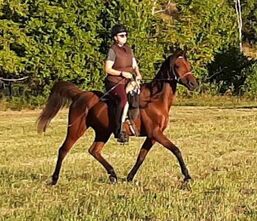 But there really shouldn't have been. Sarah and Starlet have been a dream team for years, and the ride went flawlessly. This was the first time that Starlet was alone without her friends, both in camp and on trail. That's really tough for Starlet, who is very unsure by herself, but she was an absolute pro from the moment she set hoof off the trailer. She ate and drank well, and stayed calm and alert in her corral the entire time. She even did the entire first loop of the ride alone, which can be challenging for Starlet. The beautiful trail was all hills and rocks. This is very challenging for horses who live and train only on soft footing and flat forest ground, but Sarah's fantastic horsemanship meant that Starlet was happy, surefooted, and strong for the entire ride (minus the unplanned dismount when a large tree branch broke right next to them and spooked Starlet. Sarah finished the next 21 miles with a nice bruised back). 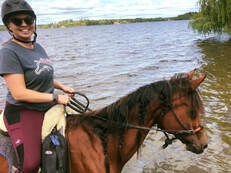 The ride day was cold and humid, a difficult mix for horses who are exerting themselves because they can't cool themselves very efficiently. Coupled with periods of strong sunshine, it was a complex mix of changing conditions throughout the day. Sarah and Star looked fantastic warming up in camp, and looked even better storming up the hill to the finish line after 31 miles (50 km), passing the final vet check with flying colours! 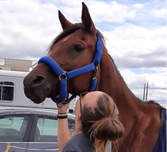 Sarah and Starlet finished this 31 mile Set Speed ride with a Grade 2 score, the second highest grade possible. In Set Speed, score is determined by a formula incorporating both ride time (speed) and heart rate (measuring how physically stressed the horse is). What an fantastic accomplishment for a 20-yr-old flatlander horse and her wonderful rider! 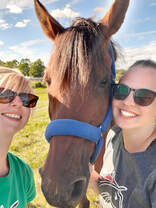 And as for me? I learned some lessons. I learned that everything is not going to implode if I'm not hyper-vigilant and thinking of a hundred things at once. I have incredible horses with extremely competent horsewomen, and the bonds between them are more than sufficient to ensure that everything is done well - while having fun! I remembered how fun it was to be the "angel" helping with other horses in the crew area while waiting for mine, I gained much more sympathy for my poor hubby standing around waiting for us to appear off a loop... and after a full day of crewing my body sure knew that it's a heck of a lot easier to be on the back of a horse than your feet all day long!! ** This post is reproduced from the Wildfire Arabians Facebook page, written shortly after the event. An update from 2020 is included at the end** As some of you know, after 25 miles (out of the planned 50 miles) at the Merrickville Endurance ride last Sunday our beautiful Vienna started showing signs of colic. She was treated at the ride and showed improvement, but then took a turn for the worse. 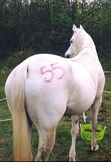 Vienna was rushed to the Prescott Animal Hospital where the prognosis seemed extremely dim (strangulating obstruction) and, since surgery was unlikely to improve the situation, euthanasia seemed like the most likely outcome. After a few more tests and an ultrasound the vets decided to treat Vienna for proximal enteritis instead of strangulating obstruction, and started her on a cocktail of pain medication, antibiotics, anti-inflammatories, muscle relaxers, and digestive aids, as well as put her on intravenous fluids and introduced healthy bacteria into her gastrointestinal system. Over the next few days, Vienna was carefully monitored by the vets and soon started to improve. She was cleared to come home on Thursday [five days later], and was extremely happy to be back out with her friends! She is currently dozing happily in the sunshine, and is eating and drinking perfectly (and, of course, bossing poor Scarlet around). The cause of proximal enteritis is believed to be endotoxemia from Salmonella or Clostridium bacteria. The source is unknown. Basically, there is no way to predict or prevent infection, and it's not due to poor environmental management, overworking/underconditioning, or mismanagement during competition (the three things I automatically started to obsess about). It was just "one of those things." 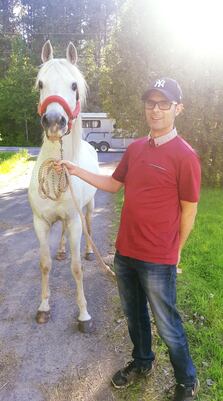 Vienna quite literally would not be with us today without an incredible group of people directly and indirectly working at and supporting her recovery. We can never repay Dr. Art King for recognizing that we needed a treatment vet, Dr. Ben Henderson coming to site from the Prescott Animal Hospital, Ride Manager Laura for racing Vienna to the clinic after being Ride Manager for a full weekend, Lauren for perfect riding and then monitoring Vienna, so many OCTRA people assisting with hand-walking and calming a hysterical owner, as well as following up over the following days to see how Vienna was progressing, and the Wildfire family who visited Vienna in hospital, kept each other comforted and informed, and now watch over her extra carefully like guardian angels. After proximal enteritis, most horses are completely fine for the rest of their lives. Some are at higher risk for laminitis because of all the inflammation, and some liver damage is possible. Vienna will be treated for ulcers and remain on preventative ulcer protocols to ensure that her gut bacteria gets all the help it needs after such a traumatic event. 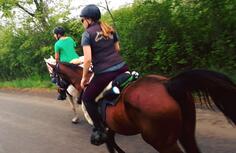 And now on to the great news! Last weekend, Sarah Workun completed her second 50 mile ride (her first was three years ago!) - and the second 50 mile ride in pouring rain!! 20-year-old FS Starlet completed her fourth 50 mile ride - her first with her best buddy Sarah. 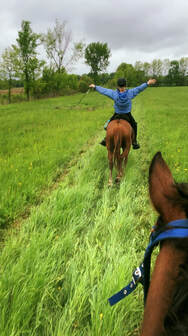 This was also the fourth 50 mile completion for Summer Wildfire (Sasha), carrying Kelsa Staffa. Fancie Footwork (Vienna) completed 25 fantastic miles in the lead with Lau Ren before starting to colic. Lauren was a fearless leader and force de nature on trail (as usual!), then immediately dedicated herself to ensuring Vienna's recovery. An incredible horsewoman all around. (A note: Vienna had responded very well to treatment and seemed to be on the mend, or we would never have gone back on trail with the other two horses. It is a decision that is very difficult to live with. Once it was clear that Vienna needed further emergency treatment, she was rushed to hospital immediately. Infinite gratitude and thanks to Sarah and Lauren for clearing up camp alone and getting Sasha and Starlet safely home, as well as so many people at the ride assisting us). All three horses were absolutely phenomenal on trail, and these two incredible ladies continue to be the ultimate competitors: fun, gracious, silly, courageous, hilarious, sassy, and dedicated to the Wildfire mares. Update from February 2020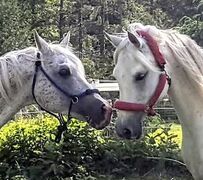 Vienna made a full recovery after her ordeal, gaining weight back quickly and easing back into conditioning. In July Vienna was confirmed in foal to TR Prince Nari for the very first Wildfire baby, and is currently sharing a paddock with Prince Nari (she is definitely head of the household!). We can't wait to see what 2020 brings! As the days get longer and we start looking forward to the upcoming summer events, I thought this would be an opportune time to reflect on our journey so far with TR Prince Nari. 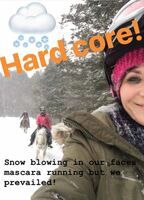 Why we chose TR Prince Nari I’ve already written about what we were looking for in a herd stallion here. At Wildfire Arabians we’ve built a reputation for being a family – a group of smart, funny, and welcoming riders who know don’t take themselves too seriously, how to have fun, and are always up for a challenge. This requires a certain kind of horse: one with the drive for Endurance, the patience for children, and the silliness to deeply amuse riders and visitors alike (a note of caution: this silliness can also cause frustration and deep humiliation when, after five years on the same trail, a horse decides they’ve never seen a bridge before and takes 20 minutes to set hoof on wood. Be careful what you wish for). 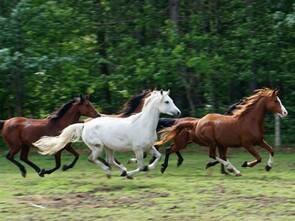 Every breeder has their own priorities in terms of genotype, phenotype, and personality, and at Wildfire Arabians the most important one is personality. That said, we wanted quality bloodlines, as well as a correct, athletic horse. All three Wildfire mares are bred quite differently. Sasha (Summer Wildfire) is a typical CMK-type mare, muscled and able to stop on a dime. Vienna (Fancie Footwork) is a petite, upright dynamo with a mix of Polish race lines and modern show lines. Star (FS Starlet) is a race-bred mare, half Polish and half Russian, built more like a Thoroughbred. We wanted our stallion to complement all three mares, without sacrificing what we really wanted: Old World breeding and that traditional hardy Arabian horse. There were a few horses who checked all the boxes on paper, but didn’t give that “feeling.” Sometimes it’s just one thing that just wasn’t quite up your alley – a type of bloodline, a history, or even a far-off location you just weren’t interested in – and sometimes, it’s not even anything to do with the horse. If you’re around horses long enough, you get to experience a lot of different types of people, and when you’re making an expensive and heartfelt decision, you don’t want to have a weird feeling about the person you’re dealing with. One or two of those weird feelings turned out to be completely justified; some of them probably weren’t, but once you connect with a seller and feel like you can trust them – particularly if you are making a purchase sight unseen – it makes the impending investment that much easier. 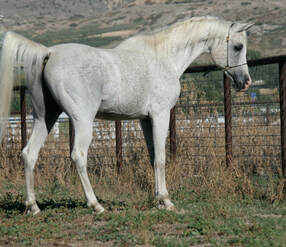 TR Prince Nari was born and lived at Taylor Ranch in Utah his entire life, and you better believe I did some pretty intensive and extensive digging about the farm’s history, owners, trainers, and training methods. The last thing I wanted was a stallion “trained” with some of the Arabian show ring halter methods, one who spent his life in a stall, one who had never been around other horses, or any myriad of other red flags when thinking of a stallion (or horse, really). Jesse and Isaac Taylor both answered a significant number of questions, provided all information requested, and – most importantly – appeared to be friendly, respected members of the Arabian community, with an oft-visited farm and happy horses. After providing reassurance and support during a monumental decision, Jesse and Isaac sent Prince Nari off to his new life in Canada, and now follow his adventures on the Wildfire Arabians Facebook page. 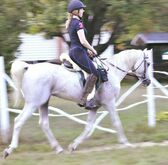 Prince Nari in Canada Prince Nari was tested out in the outdoor ring two weeks after he arrived, because some new owners are not very patient! Prince Nari had been trained under saddle as a youngster, but as it was so long ago there wasn’t much detail available, except that he had never been on the trails. After performing beautifully twice in the ring under saddle, both alone and with another horse, Prince Nari hit the trails… and a new chapter started. 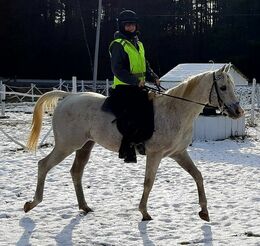 From the moment he set hoof on the trail, Prince Nari knew what to do. We call him “the Pegasus” for a reason. He was, and is, absolutely straight as an arrow, ears perked ahead, and dedicated to the mission (he seems to think that the mission is to churn through the miles as effectively as possible, which means that walk or rest breaks are pretty high on his list of dislikes, although he’ll tolerate them). He treats new trails like he’s been on them all his life, rides with geldings and mares in heat – he vastly prefers to be in the front in all cases – is fine meeting and passing other horses on trail, doesn’t mind snowmobiles and ATVs, and seems to truly love his new job. 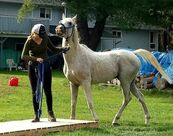 Prince Nari is an independent horse, though, and is definitely not without his quirks! He doesn’t appreciate stepping through puddles, and he’s very suspicious of fallen logs if they’re too straight (crooked ones, oddly, are fine). Bridges took a bit of ground work to get used to, and if he sees people on the trail up ahead he gets a little worried. He’s lunged over cavaletti, but doesn’t seem to enjoy it much. 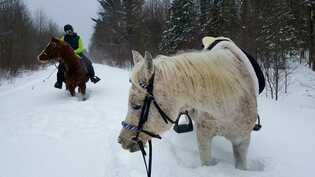 His one main bugaboo, however, is deep snow. We ride year-round, and during the winter certain paths can get very deep or have deep sides past the groomed part. The only times his silly rider has fallen off – twice to date – has been when Prince Nari accidentally put a hoof or two off into the deep snow and fell into snow up past his chest. The first time, he panicked and ran home (safely), leaving a very sad rider to schlep home alone for an hour through massive snowdrifts (this exercise does make one extremely grateful for all the times said horses didn’t make you walk home). The second time, he only had a moment of panic before catching himself, after which he went on to have a great ride. So, another winter season of riding and he should have the same reaction we all have to snow, which is: “SIGH!!” 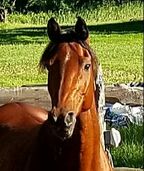 Prince Nari’s future Prince Nari was purchased to create the next generation of Wildfire horses. We’re a very small operation, so we’re hoping to have maximum one Wildfire mare off pregnant per year so that the other two can still be in work rotation. In mid-May we’re going to put Starlet out with Nari for a couple of cycles. Star is now 20 years old, and had her last foal eight years ago. Since then, we’ve tried breeding her twice to two different stallions, and she didn’t catch. As much as we’d dearly love a Starbaby, we’re not counting on it. If she and Prince Nari get along anyway, maybe the two will stay pasture mates! 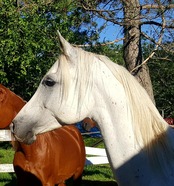 Vienna will be bred with Prince Nari following her 50 mile ride at the beginning of June, and Sasha will be bred in 2020 (keeping in mind that horses do not care a whit about best laid plans). We spend a lot of time laughing about the babies we hope for. A Starbaby with Prince Nari would be the most powerful cruise missile. A Viennababy with Prince Nari would likely be a hilarious tornado of determination and personality. A Sashababy with Prince Nari would probably be so easy and uncomplicated - right until the stubbornness kicked in! 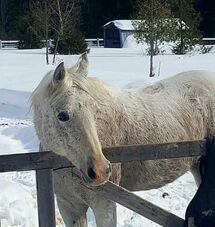 Prince Nari has thrown us for a loop, though. Suddenly, we have an incredible athlete on our hands, a strong, smooth, fun ride who could probably do a 25 mile ride right now, and definitely has the potential to do a 50 mile ride later in the season. Considering how much Prince Nari loves new trails (and trails in general), he would probably greatly enjoy an Endurance ride. The only question marks for us are stallion management considerations, such as trailering and camping. We’re planning on doing a couple of test events at the farm this summer, which would give us some time to think and plan. Then there’s a local 50 mile ride coming up in October… will there be a Pegasus sighting?? 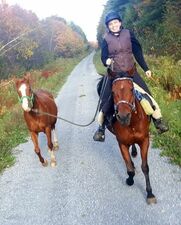 On a crisp Friday afternoon in mid-October, Sarah and I rode Vienna and Starlet four miles over to the Lopin' Larose base camp. Sarah ponied Sasha, as Vienna and Sasha don't mix in close quarters. Once we arrived we vetted through with no problems, and settled in for several beers with several friends. Night falls early in October in Canada, so bedtime was pretty early too... and with the sinking sun, the temperature dropped even further. I can safely say I've never passed a colder night in my life. Even with a cold weather sleeping bag and several horse blankets, I was legitimately convinced I was getting hypothermia! Sarah let me come snuggle in her sleeping bag, but it was only marginally warmer. Eventually the torture was ended by the alarm clock ringing 6am. 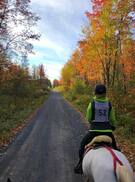 The first loop, 12.5 miles, passed by with no issues, with the Sassy White Dragonpony happily leading the way. The scenery was gorgeous as always, and it was fun to spend time on the Larose Forest trails on the opposite side of the forest to Wildfire Arabians. The horses had low heart rates and passed the vet checks with all As, and riders spent the vet check making sure that no one got a chill (horse or rider) in the cool temperatures. Since in Competitive Trail Riding you manage your own hold time, we took about 20 minutes and headed back out on the second loop. 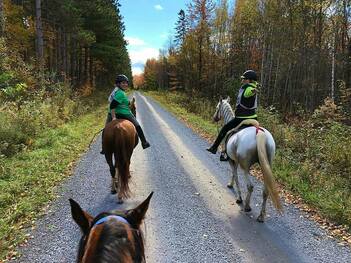 The second loop was the same trail as the first. We had some time to kill at the end (you have to come in within 5 minutes of the prescribed time) so we walked a good portion of the last mile or so. When you spend most of your time trotting and cantering, it's amazing how slow a walk feels! At the final vet check, Vienna vetted through with all As. Starlet was next, with a low heart rate... but she was very reluctant to do her trot-out, which was highly abnormal. The vet took a look, and in a shocking twist, it turned out that Starlet was very slightly sore in both shoulders and both sides of her lower back. This was baffling to all of us, as Starlet was her normal energetic and willing self on the trail; however, she is also a very stoic horse and never complains, so her performance in the second loop was a testament to her wonderful disposition and great attitude. 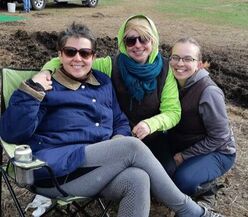 Sasha was up next, and in another surprising turn of events it turned out she was slightly tweaky on one side of her lower back. Needless to say, after a very fun ride this final vet check was a bit of a downer, especially as we had been planning on doing a 50 mile ride on Sunday with Sasha and Starlet! After the incredibly awful cold of the night before, I can't say I was disappointed to avoid another night of torturous discomfort, although we were all disappointed that our goal of our first 75-mile-weekend wasn't to be. We took a few minutes to talk about lessons learned, then gave each other huge hugs, gave the ponies some carrots, and settled down to some victory beers! 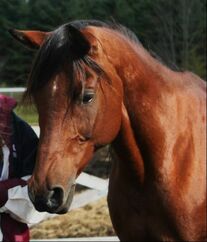 So what happened? Based on pressure points, the vet pointed to Starlet's saddle as the culprit. This was news to us, since Starlet had completed 40 miles of hills at Calabogie and 25 miles at Tay Valley this year (and all her rides in previous years) in the same saddle and finished with all As. The difference? Starlet had four weeks off between Tay Valley and Lopin' Larose, with the same grain rations as during conditioning. This was done intentionally, as Starlet loses weight extremely quickly and we wanted some extra pounds on her going into the winter. However, this also changed her physiological characteristics - meaning that she was a different size/shape than usual, which affected her usual saddle fit. A bonehead lesson learned - one I'm still kicking myself over! 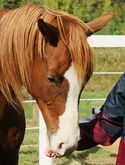 Sasha was tweaky on only one side, and the vet pointed to potential rider imbalance. One of the reasons that Starlet had been off for four weeks was that between rider injuries, family issues, and back-to-school schedules, no Wildfire riders were available to ride for a whole month. The horses didn't mind, but any rider who's taken time off knows that your first ride back you're certainly not at peak performance - especially if your first ride back is 25 miles long! So, minor rider imbalances had likely added up in the second loop due to fatigue. 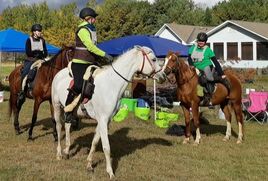 "We ride in a team..." Vienna thinks not! "We ride in a team..." Vienna thinks not! What to do differently Starlet has always been very slim and it's hard to keep weight on her. She is almost 20 years old, and we specifically wanted her going into winter with as much weight as possible. Since I wouldn't have traded her weight/condition for anything, that means an extra saddle check the week prior to a competition. Her saddle has an adjustable gullet, and if we had increased the width one size we likely wouldn't have run into the same issues. Every rider knows that life, unfortunately, can sometimes get in the way of riding goals. Due to injuries and schedules, all three Wildfire riders hadn't ridden in four weeks. Sasha's slight tweak was a very good reminder that riders have to be cognizant of, and actively correct, any small changes to form that may have crept in during time off. We ride in a team, which means we can lean on each other to point out any oddities, which is a great help! 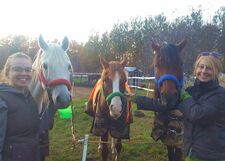 Onwards! Both horses got home and immediately ran around in their paddocks. They were happy and healthy, and we had a complete blast - so the weekend was a success in our books! Sarah goes back to university, so Starlet will have a nice relaxing winter, packing around guests. Rider injuries have been healed and personal schedules have been stabilized after the back-to-school chaos, so we'll be getting out a lot more over the fall and winter. Also over the winter, the three mares will be showing Prince Nari the trails, and the riders will start planning for Summer Fling 2019. Busy - and fun - as always! 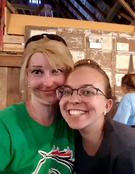 Following a hot, humid summer - which led to fantastically dry trails! - we were more than ready to head off to our first Endurance ride of the season. We only attend those within a couple of hours of home, but last year had missed the inaugural year of the Calaboogie, held in Calabogie, ON, a resort area home to beautiful hills and lakes. We had planned to take all three horses, but at the last minute Alex slipped a disc in her back and couldn't ride. Originally I was going to ride Vienna and send Alex and Sarah on ahead, as Vienna needs a slower start to work through some emotions, but as Sarah rides Starlet I decided to take Sasha, as they pace best together. Our pre-arrival strategy was to try to increase our speed in relation to our previous rides, as we've never even approached the "yellow" zone of the horses' comfort, let alone the "red" zone, and where better to do it than with experienced and amazing vets around? 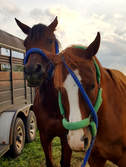 We arrived at camp and got the horses settled in without any hitches. When setting up our crew area we got our first hint of what was to come. After asking riders how their rides went we had answers ranging from, “so beautiful… but super technical” to, “Ohmygod… HILLS!!” The head vet, Dr. King, also stressed the technicality and difficulty of the trails during ride talk, reminding riders to be aware of the additional energy that inclines and declines demand of the horses, in relation to flat ground. After considering all the feedback, we amended our ride strategy to account for the hilly terrain; something we had extremely limited experience with! 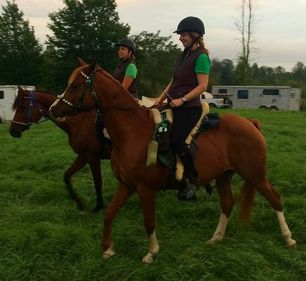 On a cool and humid Sunday morning we lined up with the other 50 milers (12 in total) to start the ride. One thing I will always be deeply grateful for is how calmly our horses approach the start of a ride. Because we, and they, aren’t very competitive it’s always a low-stress (but exciting!) start, watching the faster riders bound away down the trail while we settle into our happiest pace. We headed off to the first 20-mile loop with fellow OCTRA rider Jess, who we had the pleasure of getting to know at the Summer Fling (the OCTRA ride we host in the summer). Starlet and Sasha were faced with tall, rocky hills, which they unexpectedly navigated extremely well. I guess I need to have more confidence in their abilities! There were a couple long stretches of flat ground, which the three horses ate up, and we were surprised to find the front-runners at the mandatory 10-minute hold halfway through the loop, just ready to head back out on trail. The 10-minute hold was at a lake, which would have been beautiful if it hadn’t started to absolutely pour rain! We electrolyted the horses and gave them some carrots (thanks, awesome volunteers!) and headed out to finish the first loop. 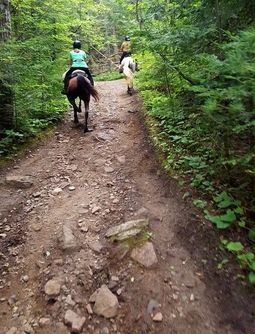 The rain continued once we were back on trail, with the horses bowing their heads to try to escape the pelting drops. The rain also made the rocks and grass on the hills verrrry slippery, so we were extremely careful navigating to avoid a slip and a tweaked muscle. We got to the first hold, untacked and cooled for about a minute (based on guesswork, since the heart rate wand wasn’t working), and went over to the vets. The horses passed with flying colours, but unfortunately we lost our riding companion Jess due to a bruised hoof. At the vet check we bundled the horses up against the cold rain and gave them their feed – soaked alfalfa/timothy cubes (just like at home) and Trimax, with electrolytes. This is where a couple of lessons were reinforced, although we wouldn’t know the full ramifications until later: DO give your crew more guidance about how soupy to make the soaked cubes (how much water to put to how many cubes) and DON’T try anything new at a ride! 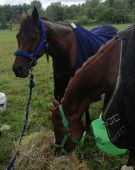 The feed was overly soupy, so the horses barely touched it – on top of that, to try to encourage them to eat the feed, some dummy (me) dumped a whole bunch of date syrup into the mix, under the hunger-impaired thinking that “horses like sugar, right?” ROOKIE MISTAKE! So we headed back onto the second loop with the horses having eaten significantly less than I would have liked. They ate dry hay and got electrolytes in syringes, but definitely did not get enough nutrients. At this first vet hold we also re-amended our ride strategy to the old standby: "to finish is to win!" 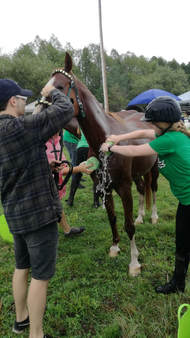 The second loop was 15 miles of constant, large rolling hills, with some long, steeper sections for variation. The scenery and trails were beautiful, just like the first loop, but the second loop definitely felt longer. The rain had stopped and was replaced by sun, heat, and high humidity. The horses were game and felt good, but definitely had less pep than on the first loop. Our second loop was almost as long as our first loop – 15 miles in 3 hours, as opposed to 20 miles in 3 hours – and as we came into the second hold we were DEFINITELY feeling it! Muscles that had never hurt during previous long rides were feeling the strain, and we were feeling pretty darn shell-shocked. It’s one thing to know, academically, that hills take a lot more out of you than flat land; it’s another thing to experience it and learn it on a profound level. Neither of us, and neither horse, had ever experienced any sort of terrain even close to the elevation changes at Calabogie (which to some people are probably laughable, but to us – who have literally not a single hill in our forest – were boggling), and the energy expenditure were becoming both physically and mentally draining. 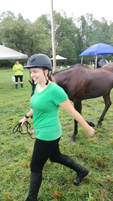 The horses vetted through with good hydration parameters and gait, but both horses had low gut sounds. This is where I really kicked myself for making such a dumb mistake with their feed at the last hold. Neither have ever had low gut sounds before at any ride, at any distance! They just simply did not have enough fuel in them. They ate and drank well at the hold – less-soupy soaked hay cubes, dry hay, and several apples – although of course, I would have preferred that they ate even more. We gave them an extra five minutes at the hold to see if they’d eat a bit more, then mounted up and headed out on the last loop. 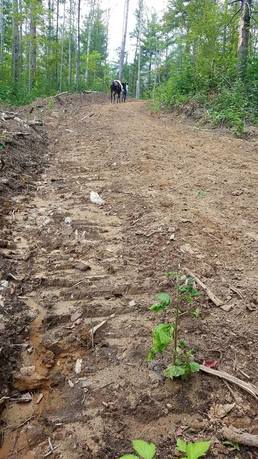 The last loop had long, steep inclines. We knew from the ride talk that there were sections of flat trail within the loop, but we hadn’t encountered them yet. Both horses and riders were flagging, so when we came to the bottom of another long hill we stopped. We looked at each other – two very determined ladies and two wonderfully willing horses – and had a quick pow-wow. Neither rider wanted to “give up”… but then again, what were we trying to prove, exactly? We weren’t trying to qualify for anything, or going for points, or trying to make a name for ourselves. We had set out to challenge ourselves and have fun with our amazing horses, and that we very surely did! Pushing the horses further would only increase their risk of injury and turn an exhausting but gratifying challenge into a sour slog. So we turned back to camp, and by the time we returned we had completed 40 miles of pretty darn difficult terrain. We took a Rider Option and the horses vetted through with no problem and very low heart rates (48 bpm for Starlet, and 52 bpm for Sasha), and happily stuffed their faces into bowls of wet hay cubes. We got proud hugs from our crew – listen, 40 miles of hills is nothing to scoff at! – and sincerely thanked our amazing horses for their surprising skill and dexterity on challenging trails. 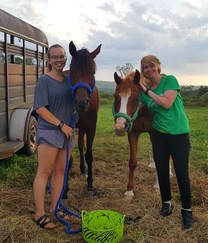 Could we have completed the course? Yes, and in the time allowed. However, it wouldn’t have left a good taste in our mouths. Our horses were tired and probably wouldn’t have enjoyed it; plus, the chance of injury on the hills increases exponentially with fatigue. And we riders were both physically and mentally tired, using different muscles riding up and down hills and watching the trail carefully to safely guide the horses. So, we eventually made peace with our decision to end on a tired-but-happy-and-proud note and tucked into a couple of beers with other riders and crew! 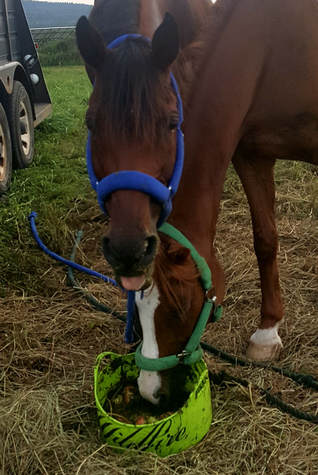 Lessons learned - If you know there are idiosyncrasies about your feed or how your horses like their feed, don't expect your crew to magically understand vague instructions about how to prepare it! The horses weren't very interested in their overly soupy hay cubes the first hold, because I hadn't explained the ratio of water to cubes, or that the cubes need to be ripped into small pieces for better soaking, etc. Totally my fault, not that of our super amazing crew. - For goodness sake, don't try anything new at a ride! This is the golden rule of Endurance riding, one I follow extremely carefully, and yet I fell into the trap anyway. If your horses haven't tasted date syrup at home, don't bust it out at a ride, and certainly don't just wing it in terms of quantity and delivery method! The horses would have had a lot more in the tank if I hadn't made a hunger-impaired decision. Which leads me to... - Bring snacks on the trail, particularly during a 20 mile loop. I've learned this the hard way before, but apparently not enough, as I came into the hold starving and fatigued after a small breakfast at dawn. Not only did that make the ride physically harder than it needed to be, but also it also led to irritability focused at my crew (I'm sorry, you awesome, wonderful people!) and poor decision-making. Bring those darn granola bars!! - The Wildfire horses really ARE much fitter and more skilled than I think. This is the first year where I've had the mentality of, "why not see what we really CAN do?" as opposed to a much more conservative and cautious ride strategy. Starlet and Sasha absolutely shocked me, being able to complete 40 miles of rocks and hills that they'd never experienced before, and at a pretty decent pace, and I think it gave me more confidence in their welfare even if we push them a bit. 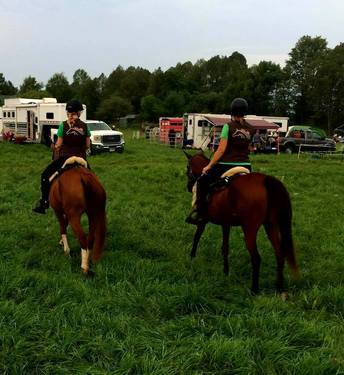 Next year Will we attempt another 50 miles at Calabogie? Honestly, probably not. We don’t really train or condition for Endurance riding; it’s just a fantastic side benefit of riding through the forest where we live. Our forest is completely flat and we never go out-of-forest except for a few local Endurance rides. We don't really have the desire to trailer our horses elsewhere (i.e. to train on hills), so it wouldn’t be any more fair to ask the horses to complete the Calaboogie 50 next year. Next year we’ll probably do a lower distance and reap all the benefits of such beautiful trails without pushing our horses past what we’ve prepared them for. And you know what that means… more time for wine!! 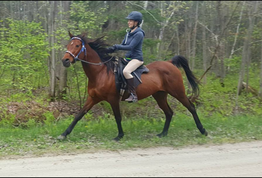 When I was a kid growing up reading every horse book I could lay my hands on, three things stuck in my brain as the most terrifying events that could happen to a horse owner. These were: - breaking a leg in a groundhog hole; - laminitis; and, - colic. I had never experienced any of these before, but in December I was introduced to colic. On a cold day in early December Starlet was found laying down next to the hay bale. She was incredibly still, didn't move her head, and didn't want to get up. Neighbour Madison and hubby Bryan brought out blankets to cover her up - she wasn't wearing a blanket, which is usual for her - while I called the vet and raced home. By the time I got there Starlet had got up herself and Madison and Bryan had her in the barn. The vet diagnosed Starlet with impaction colic. She used water in a nasogastric tube - distressing to watch, and probably pretty unpleasant to experience - to pump out Starlet's stomach. Once no more hay was coming out (and lots and lots of water had gone in), the vet left and we converted two cross-ties to a temporary stall. 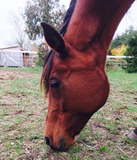 Here's where Starlet's temperament worked to her advantage: the vet gave instructions to walk Star for ten minutes every half hour and monitor her bowel movements. Starlet really, really dislikes being alone, so she walked herself in her stall pretty much constantly, with me checking on her every 15 minutes and going on walks with her every 30. She wasn't allowed to eat anything, but could drink as much as she wanted. After five very stressful hours, she pooped (yay!). Over the next 36 hours we very slowly introduced very tiny amounts of hay while continuing her walks every couple of hours, and she continued to pass stomach content. She was alert and a model patient, and rejoined her friends after 48 hours with no lasting harm. Root cause analysis points to sudden and deep sub-freezing temperatures resulting in a decreased desire to drink water; compounded by the fact that the dummy horse owner (me) had forgotten to plug in the trough heater, making the water extra cold and unpleasant. Starlet's temperature was also low, so she probably lay down at some point on the cold ground and caught a bit of a chill in her bones (she's 19), also not encouraging her to get up and drink (or move around). 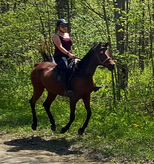 Considering some people have stories of their horses not passing stomach contents for five DAYS (!), we really got off lucky with this incident. There are many reasons why a horse might get colic - the Internet is a great resource, if also extremely likely to make you paranoid - but access to warm water during colder temperatures seems to reduce the chance of colic. We also always make wet grain, but in the winter we make it extra soupy (and salty) to encourage more drinking. Hopefully I'll never see another horse in such distress. 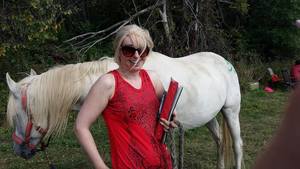 Horses. Competition seasons. Probably the greatest source of unknowns and curveballs in the average rider's life. Case in point: our recent adventure of "Madison's First 50 Mile Ride." Spoiler: There was no 50 mile ride. Not for the Wildfire family, anyway... Madison and I had been bouncing around all week looking forward to the ride on the weekend. Madison's first 50! Sasha's first ride this year! Gorgeous weather! We loaded up Vienna and Sasha on Saturday morning and arrived in Perth in early afternoon, registered, set up our tent and canopy, and prepared lunch for the ponies. 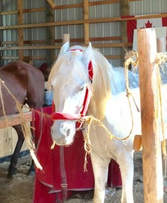 And that's when the Sassy White Dragonpony came to life... Vienna kicked Sasha in the electric corral, and caught her right on her butt cheek. A new electric dividing line was set up (never mind that we hadn't needed a dividing line for the last three years) and the horses were segregated, and after they finished eating we went over to the vet area to vet through. Only... we didn't. Neither horse passed the pre-ride vet check. 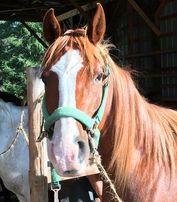 When Sasha had been kicked she tucked herself under and tweaked her lower back. She was fine on the straight trot-out, but unhappy on the circle. As for Vienna: A deer or moose had pulled down one of our electric lines last week and so the ponies wandered over to the neighbour's property; a property that has semi-buried barbed wire fence. We noticed that Vienna's back leg was covered in surficial scratches, but had no serious damage. She was not lame, and we went for a lovely ride this past Thursday. By Saturday's vet check one of the scratches had apparently become infected, and her leg was warm and slightly swollen. She, too, was fine on the straight trot-out, but did not want to extend that leg when trotting on the circle. Second horse: also out. 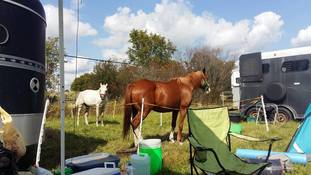 Talk about disappointed! We called our trailer guy, and he set back out to Perth to pick us up. Meanwhile, we had checked with the ride admin staff and been told there was no refund available. Even more disappointing! However, after chatting with a couple of experienced riders we discovered that we were almost definitely entitled to some money back, which would at least mitigate some of the sadness we were experiencing. There was some confusion when we went to talk to the ride admin staff, but it turns out that there were some misunderstandings and that we will likely get some of our ride entry fees back. So that's a small bright spot. 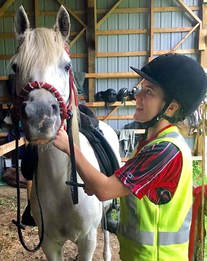 But... a SMALL bright spot. We are still out money for trailering, not to mention incidentals (food, gas etc.) for the weekend. I've never not been able to start a ride before, and it SUCKS. Bringing two horses to a ride and neither being fit to start? Talk about feeling like an ignorant horsewoman! The worst part for me is knowing that Madison's first experience with the sport is disappointment (and expense with no return). I love my horses, who are now injured (although not grievously); I love this sport, which I want to experience more; and most of all, I love to bring new people into the sport and have silly fun and watch them become as excited about Endurance riding as I am. My last chance to do that this year will be at Lopin' Larose in October... here's hoping we actually get to ride! Just par for the course for Competition Season 2017... !
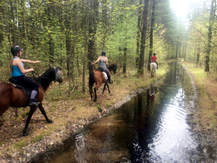 This year (or at least Spring/Summer) has been full of frustration, disappointment, and ongoing attempts to keep a positive outlook. In July (so far) we have had 248mm of rain, following a June with 130mm of rain, a May with 177mm of rain, and an April of 148mm of rain. For reference, Ottawa usually averages around 73mm of rain per month. In short, it is wet, and it has been wet for months, and it is going to be wet for who knows how much longer. The forest trails are flooded or deeply muddy, the normally-dusty paddocks are wetlands, and the abnormally large mosquitoes are persistent clouds no matter where you go. 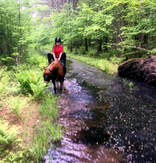 All of this has led to a very weird summer here at Wildfire Arabians. While we can (and have) ridden in torrential downpours, it's not really the most fun. While we can (and have) slogged through miles of water over the horses' knees, it's hard to enjoy while being eaten alive by mosquitoes (and trust me, we use all the tricks to deter them. But 1% of 5,000,000 is still a lot of blood being lost to voracious mosquitoes). There are only so many trails in existence, and when all of them are equally unpleasant to ride it not only limits your options but also limits your appetite to grab a horse and go for a good, fun ride. 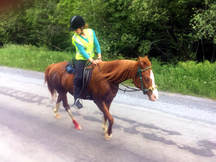 On top of the soggy condition of the trails, Sasha has also been out of commission for two months. After going through a deep puddle on an often-used trail she came up missing a chunk of flesh from her fetlock approximately the size of a tennis ball, and almost an inch deep. It is likely that the incredible rains led to an old, unknown culvert, long covered with years of soil, to be exposed. While Sasha wasn't lame (thank goodness no tendons or ligaments were injured), it has taken a while for all the tissue to re-grow in the area. Coupled with the fact that Starlet is currently off property, we are down to one Wildfire mare... ! 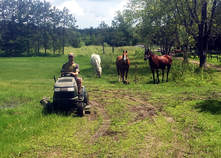 With all the curveballs that have been flying around this summer, just a few of them mentioned above, it looks like a very limited competition season for us (and indeed, a very limited riding season in general). And that has been hard to accept. Waking up on a weekend morning and staring out the window at persistent, cold rain instead of bouncing outside to hit the trails has been hard. Watching one of your horses slowly lose muscle tone while agonizingly slowly regenerating tissue has been hard. Having farm projects and summer plans put on hold has been hard. This summer.... has been hard. And that's okay. 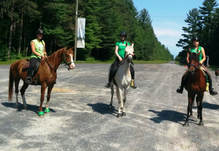 It's okay that we haven't been riding nearly as much, because we miss it, and it will be so incredibly wonderful once the winter hits and we can get out and gallop for miles on perfectly-groomed trails. It's okay that we will likely only get to do two competitions this year, because we're not aiming for the Olympics, and we're not aiming for Year End points, and we're not out to prove anything, and to be honest we have just as much fun drinking wine on trail while cantering through the Maple Farm. It's okay that maybe all our over-achieving farm improvements won't be completed in one season! We are so privileged to look out our window and see our horses. Life is so complex with so many bouncing stars that we're just lucky they have ever come together to give us three happy horses, several riders with enough time to actually ride, and sunny summer days with soft, dry forest footing. It has happened before, and it will happen again. I hate the phrase, "there is always next year." Yes, I know, but I want it NOW! But I'm learning to make peace with the fact that there are times where our big dreams of hitting the trails after work and checking out new competitions and hosting informal events at the farm just have to be put on hold. And that's okay.  Winters in Canada are unforgiving. We get temperatures down to -25°C (-13°F), several feet of snow, and arctic winds that feel like your skin is being stripped away. Periodically we also get beautiful warm sunny days, which seem like a brief respite but actually melt and re-freeze the good footing into sheets of sheer ice. So what do we do all winter (other than curl up by the wood stove and drink homemade cider)? 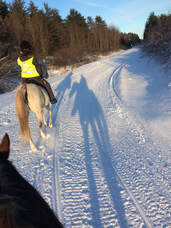 We ride! Wildfire Arabians was founded bordering the Larose Forest, which boasts many user groups including ATVs and snowmobiles. This means beautifully-groomed packed-snow trails throughout the forest. We share with the motorized vehicles - Wildfire horses aren't keen on a group of forty stinky, roaring machines sliding by, but will tolerate it - and can go for hours all through the forest. We're pretty spoiled! 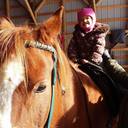 What do we work on? In general, we don't. We don't worry about keeping the horses conditioned, or pushing for our goals. The days are short and even our groomed trails are sometimes unrideable. We take this time to enjoy the winter sun and the fuzzy ponies without thinking about the upcoming competition season (in theory!). It's a great time to bring the kids out or take a hubby out for a ride!  This year we're also using the winter to plan our very first Spring ride, set for the end of May (https://www.facebook.com/events/701561253346041/). Wildfire family members are involved in everything from Ride and Trail Management to food preparation and manure pickup. Armed with spreadsheets, rule books, and wine, the Spring Fling ride should be a fantastic start-of-season ride for Eastern Ontario (and Quebec!) riders. 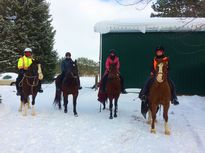 So, we are keeping ourselves busy, and it's startling to think that the first OCTRA-sanctioned rides start in only two months! (Although the first Eastern Ontario ride is a training clinic in three months, followed by our Spring Fling ride). The horses maintain (or improve) their condition with rides through snow, while antsy riders think way too far in the future about strategies for upcoming rides and excitedly plan for the Spring Fling. My next post will likely be about the joys and challenges of being a Ride Manager, for those of you who want to charge down that road! |
About
This blog is about close-knit friends learning and succeeding together as we achieve personal distance riding goals. It will generally focus on milestone events and lessons learned, and will serve as a diary of our journey through the world of Endurance. Author
Kelsa Staffa, Owner and Trainer at Wildfire Arabians |
